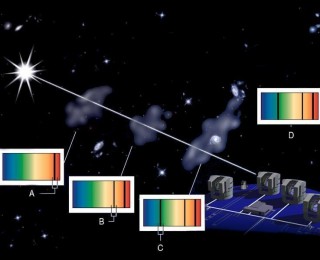
by Elizabeth Lovegrove | Feb 13, 2012 | Daily Paper Summaries
When the light from a distant quasar finally arrives at Earth, it often carries far more information than it did when it was emitted – the shadows of gas and galaxies that have intervened over the cosmic distances between us and the source. These features can tell us how the universe evolves in both space and time, by allowing us to sample both low and high redshifts for structures that would not otherwise be visible. This paper uses a new IR spectrograph, FIRE, deployed on the Magellan 6.5 m telescopes, to present the first high-redshift sample of Mg II absorption systems, including the most distant Mg II system yet found (z = 5.33). The authors show that the number of strong Mg II systems appears to peak and decline in number along with the star formation history of the universe, suggesting a correlation between the two, while weak Mg II systems stay mysteriously constant.

by Elizabeth Lovegrove | Jan 17, 2012 | Daily Paper Summaries
Dark matter is not so dark as the name might imply. Although it so far refuses to interact with normal matter via any force other than gravity, there are secondary signals that we can detect. When we turn our gamma-ray telescopes on regions like the Galactic Center that contain a high density of dark matter, we expect to see a dim, widespread gamma ray haze coming from seemingly empty space, with no baryonic matter source. This paper, due to be published by the Astrophysical Journal, discusses the search for this signature by the collection of satellites that surrounds the Milky Way, and uses the lack of a detection to set an upper limit on the cross-section of the WIMP particle.
by Elizabeth Lovegrove | Dec 20, 2011 | Daily Paper Summaries
Those watching the sky in August may have heard the news that a new star had appeared: the type Ia supernova PTF11kly (later rechristened SN2011fe) had touched off in M101, the Pinwheel Galaxy, a bare 6.4 Mpc away; close enough that for a brief period the supernova was visible to anyone with a good pair of binoculars. As the closest recent type Ia observed, astronomers were able to use it to place the first direct observational constraints on the progenitor of a type Ia supernova.
by Elizabeth Lovegrove | Dec 11, 2011 | Guides
You’ve probably heard the old quote from Cosmos that “we are all made of stardust.” But that’s not the whole story. How that dust gets made is an intricate tale that spans a wide range of stellar processes and masses. This is the field of nucleosynthesis, the making of the chemical elements, and it is what allows us to make the simple statement: toothpaste comes from neutrinos.
by Elizabeth Lovegrove | Nov 21, 2011 | Current Events, Daily Paper Summaries
The OPERA experiment in the Gran Sasso tunnel in Italy recently shocked the physics world by announcing that they had clocked neutrinos violating that ultimate of speed limits – the speed of light. Most scientists, upon hearing the news, rightly reacted with skepticism, and the results were closely examined to unearth any unaccounted-for sources of error that could have resulted in an incorrect measurement. On November 17th, the OPERA collaboration responded by pushing a new paper to the arXiv that eliminated one of their systematics, the length of the neutrino pulses received from CERN, and found that their data still show a significant superluminal signal.


